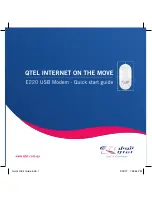
Chapter 3 – Fax Class 2 Commands
Multi-Tech Systems, Inc. SocketModem MT5600SMI/MT5656SMI Reference Guide (S000306C)
92
Command: +FDCS Current Session Results Parameters
Description:
The +FDCS parameter is loaded with the negotiated T.30 parameters for the
current session. A transmitting DCE generates DCS; a receiving DCE gets
DCS from the remote station. The DTE may read this parameter.
The +FDCS parameter is initialized 0,0,0,0,0,0,0,0 upon initialization and at
the beginning of a session. If the DTE issues a +FDCS? command in the
initial state, the DCE reports:
<CR><LF>0,0,0,0,0,0,0,0<CR><LF>
The contents of +FDCS are spontaneously reported during execution of +FDR
or +FDT commands by the +FDCS:VR,BR,WD,LN,BF,EC,BF,ST response
using the same compound parameter format.
Several commands and responses reference T.30 session negotiated
parameters. These are described by a set of common subparameters.
The +FDCC, +FDIS, and +FDCS compound parameters use these session
parameters (On writes, unspecified subparameters are unchanged.)
The +FDIS:, +FDCS:, and +FDTC: session report responses use these
subparameters.
For test response, ranges of values are reported for each subparameter
enclosed in parentheses characters. For example, a DCE response to
+FDCC=? could report:
<CRLF> (0,1), (0-5), (0-3), (0-2), (0-2), (0-2), (0), (0-7) <CRLF> (14400 fax
models)
Read syntax: +FDCS?
DCE response:
+FDCS=VR,BR,WD,LN,DF,EC,BF,ST
or
+FDCS=
Valid values:
See Table 3-2.
Default values:
0,0,0,0,0,0,0,0
Example:
+FDIS=0,5,0,2,0,0,0,1 =
VR =
0 98 dpi vertical resolution,
BR =
5 14400 bit/s
WD = 0 1728 pixels,
LN =
2 unlimited length
DF =
0 1-D modified Huffman coding,
EC =
0 no ECM,
BF =
0 no BFT,
ST =
1 5 ms scan time.
Command: +FLID= Local ID String
Description:
If FLID is not a null string, it generates a TSI or CSI frame. Table 3/T.30
includes digits 0-9, “+” and space.
If the DCE supports use of Table 3/T.30 only, the response to a +FLID=?
command is “(20) (32, 43, 48-57).” If the DCE supports printable ASCII <, the
response is: “(20) (32-127)<CRLF>.” The first “(20)” represents string length:
the second (character values) field reports supported string values.
1.
The string is saved in RAM.
2.
Non-numeric characters are not filtered out.
3.
The string is right justified.
Write syntax:
+FLID="<local ID string>"
Valid value:
20-character ASCII string
Default value:
Empty
















































